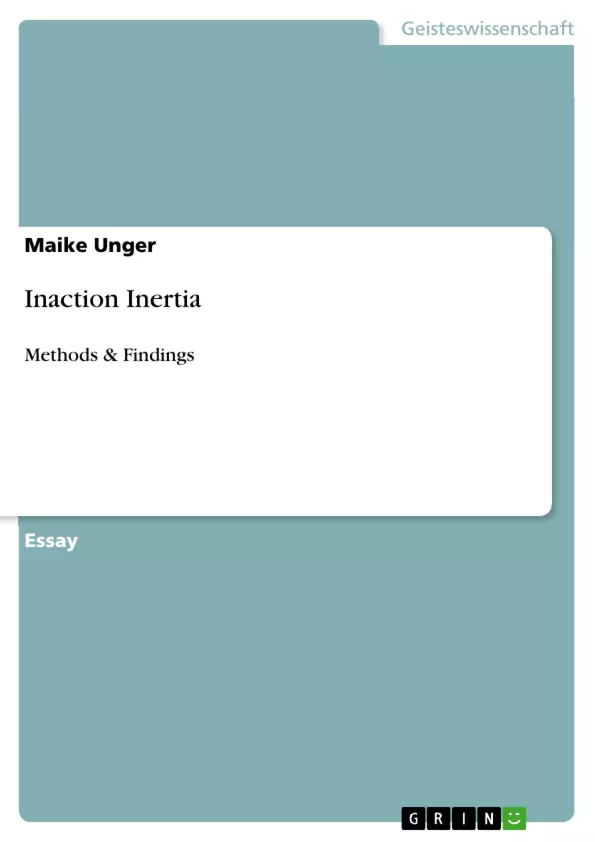Table of Contents 2
1. Introduction 3
2. Methods of the experiment 3
2.1 Participants and design 3
2.2 Procedure and measures 4
3. Results of the experiment 4
4. Flaws of the Experiment 5
5. Conclusion 6
References 6
Table of Contents
1. Introduction
2. Methods of the experiment
2.1 Participants and design
2.2 Procedure and measures
3. Results of the experiment
4. Flaws of the Experiment
5. Conclusion
References
1. Introduction
The inaction inertia effect was first introduced by Tykocinski, Pittmann, and Tuttle and is described as the phenomenon that “forgoing an attractive action opportunity (initial inaction) decreases the likelihood that subsequent action will be taken in the same domain [inertia]” (Tykocinski/Pittmann, 1998, p. 607). In that sense, inaction inertia implies that when missing an appealing offer, a less attractive but still desirable deal is likely to be forfeited. Research shows that this effect is applicable to all sorts of different goods or services (automobile purchases, renting apartments, ski passes, etcetera). The effect is even more prominent when the difference between the initial and the second opportunity is quite large (see Zeelenberg et al., 2006, p. 90). As for the question why such behavior is shown by many people, various different explanations can be found in previously published literature. First, regret is seen as a major influencing factor because it is considered a loss (see Zeelenberg et al., 2006, p. 90). Second, the devaluation of the later offer is seen as the cause of inaction inertia because the initial offer seems to work as an anchor against which the current offer is evaluated (see Zeelenberg et al., 2006, p. 98). Some evidence was found for both approaches but further research needs to be done.
In order to find out more about the inaction inertia effect, a small experiment was conducted. The general underlying hypothesis was: When individuals miss an initial offer on offer A, they should be less likely to take offer A or B when the cost increases significantly.
Adapted to our experiment our hypothesis was that people that did not miss the prize they really wanted would choose the prize that is more valuable, which, in our case, was the chess set.
2. Methods of the experiment
2.1 Participants and design
A sample of forty-one students (17 male, 24 female) at the University of Konstanz volunteered to participate in this study. They were randomly assigned to one of the two conditions/ independent variables (T-shirt not offered, T-shirt offered but not available as a prize), of the two complete factorial design (between subjects), with twenty participants in one and twenty-one in the other condition. The condition-one group consisted of nine males and eleven females, the condition-two group of eight male and thirteen female participants. In general, our experiment was designed with one treatment group (# 1) and one control group (# 2).
2.2 Procedure and measures
Participants were approached individually at different places at the University Campus. They were asked to participate in a short-term experiment and that in return they would be able to choose between several prizes. They were not told what the experiment was about. After agreeing, they were taken to the laboratory rooms and were asked to answer several questions on the computer. This questionnaire took approximately ten minutes and participants were not told what its purpose or the purpose of the experiment was. It was taken from another experiment concerning narcissism and the answered questions were not relevant to our study. At the beginning of the questionnaire they were provided with instructions. The first group was told that after completing the questionnaire they could choose between a prize of a chess-set and two Euros, but were not given the option of a T-shirt. The second group was told that they could choose between a T-shirt, a chess-set and two Euros. After completing the questionnaire the participants of both groups had to choose their prize. The first group simply chose their prize of a chess set or two Euros. Once the participants of the second group were done with the questionnaire they would return to one of the three experimenters and told them which prize they wanted. If anyone wanted a T-Shirt, the experimenter would answer that they unfortunately ran out of T-Shirts and that only the other two prizes were available. They then also chose between the remaining two prizes and afterwards had to sign a participation list also writing down their choice. The results were measured by the behavioral dimension of choice.
3. Results of the experiment
The participation list was evaluated via SPSS. In group # 1, fifteen people chose the two Euros and only six chose the chess set. In group # 2, eleven people wanted the money and nine participants took the chess set. That shows that within each group, but also across the groups, there is a high preference for the money rather than the chess set. Even more interesting is the fact that more people out of the group that was initially offered the T-Shirt chose the chess-set than did people in the group that were only offered the other two prizes. This result opposes our hypothesis, which stated that less people in group # 2 would choose the chess set than in the control group because participants of this group did miss out on a good deal and thus would chose the prize less valuable of the remaining both. However, this outcome is not significant according to the results of the Chi-Square Tests. For example, the Fisher’s Exact Test only showed a significance level of 0.341. However, even if the results were significant, they would still contradict our hypothesis.
[...]
- Citation du texte
- Maike Unger (Auteur), 2009, Inaction Inertia , Munich, GRIN Verlag, https://www.grin.com/document/136302



